|
|
|
|
 | ||
|
Page 26 Where to sketch? (summer, 2005) All week long I look forward to my sketch day, and when the morning finally arrives, I have no idea where to go. Happens every week -- I'm hopeless. Recently it hit me that one good option is to simply choose a place I would want to visit even if I weren't sketching. It might be a part of town that draws me at the moment, or maybe an all time favorite area. Once there I should be able to find something enjoyable to sketch. For this sketch I took a bus to one of my all time favorite parts of town -- Asakusa. It's old and very down to earth, with lots of old wooden structures. 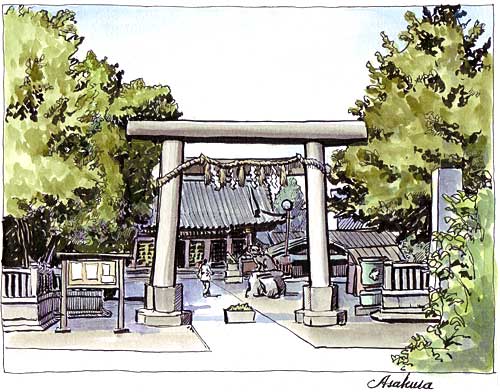 This is one of many old shrines in the main compound. I found an out of the way place and set up my newest folding stool (see below) and started sketching. First I made a rambling contour line very lightly until I had a good idea where everything would go. Then I began sketching with brush and ink, following up with watercolor. It was an extremely hot day, but still enjoyable. The next sketch was done nearer to home. I took my bicycle and started riding around until I found an appealing scene. I settled on this row of stores along a sidewalk with the summer "Tanabata" festival decorations still adorning lamp posts. It's the kind of scene that has an irresistible draw, beckoning me to come and explore. I figured it would make a good sketch for the same reason. 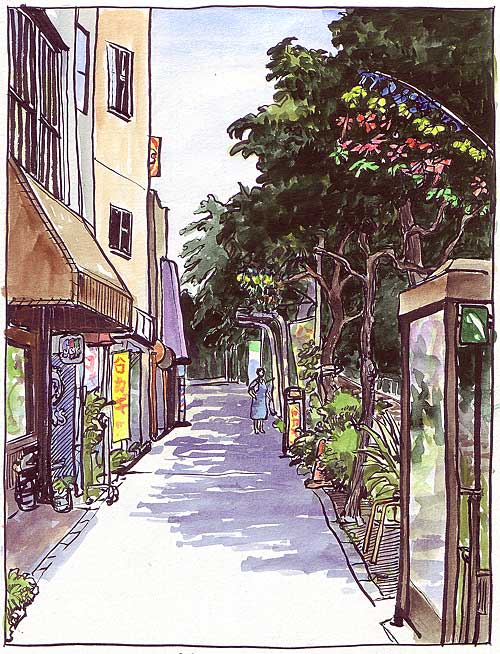 I stood up for this sketch because it was a fairly busy corner. Since my back was to the street, only the bravest of souls would venture into traffic to peek over my shoulder, and a few did. Here are a few more flower sketches. There's a flower park across the street from my church, so on Sunday afternoons I have a chance to go over there and sketch a few flowers. It's interesting to see different types of flowers come and go as the weeks go by. I still know nothing about flowers, and don't even know what these are called, but they are great subjects to sketch. No boring straight lines, lots of color and natural contours. 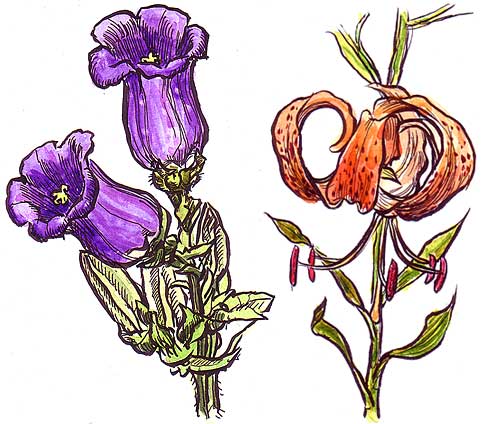 The purple flowers on the left were drawn with a yatate brush and sumi. The orange flower on the right was drawn with a brush pen and carbon ink. Both were colored with regular watercolors. Those who know what these flowers are called are probably chuckling at my ignorance now.
Hokusai stated that his goal was to produce art where every dot and stroke was alive by the time he was one hundred and ten years old (he lived to be eighty nine). This emphasis on the beauty of line was foremost in the minds of Japanese artists back when the brush was the only drawing tool around. Outside of traditional Sumi paintings, I see very little line variation these days when most ink sketches are done with "Micron" type pens or technical pens, and the emphasis is on the over all effect rather than the individual strokes. I'm not criticizing these tools or this style -- I enjoy using them myself sometimes. It's just too bad we don't see more of the old "organic" style where the individual strokes have width variation. In the west, just about the only place you can find contemporary drawings rendered with ink and brush is in comic books. There's a lot of great expressive line variation in comic art. (For those interested in learning this style, I've added a great book on comic book inking to my recommended book list). Flexible nib dip pens and some fountain pens can also get great expressive strokes. The only drawback is that they leave a bead of ink sitting on the surface of the paper that takes longer to dry, and can actually start to feather and bleed on some papers. Also, you are pretty much limited to getting thick lines on down strokes only. These are minor liabilities, and I love to draw with a flexible pen almost as much as a brush.
Of course, one reason you don't see more brush and ink drawing in the west is that it is far more difficult to master. The main problem is there is no tactile feedback as there is with a pencil or pen. If you take your eyes off the paper to look at the subject, there is a good chance your brush will go down or up, making either a fat line or no line at all. Most books that touch on brush drawing -- or comic book inking -- tell you to support your drawing hand on one finger (they differ as to which finger it should be). This will allow you to control the thickness of the line. Supporting your hand on the middle finger gives you the most accurate line, but it's hard to get line variation (try it, and you'll see what I'm talking about). Supporting your hand on the little finger gives the most expression but least control. I support my hand on both the ring finger and little finger, curving them in, and resting the hand lightly on the finger nails or first joint or somewhere near there. When I need tight control such as a straight line, then I switch to the middle finger. Many Sumi-e artists actually float their hand in the air with no support at all and have great success. Try to keep the brush perpendicular or nearly perpendicular to the paper to have the most freedom to draw in any direction.
I have a favorite yatate as well as Kuretake brush pens. In the brush pens I use Platinum carbon ink cartridges, or an ink converter filled with Platinum carbon ink. Recently I've been using a second brush pen with an ink converter filled with Private Reserve Gray Flannel ink. It's perfect for quick shading in gray tones. I used it in two of the sketches in this section. The two sketches of standing women were done at the same subway platform on different Sunday mornings. The sketch of the girl in the hat was done while riding the subway. In all three cases I had only a minute or so to finish the sketch before the train arrived or stopped. Pencil under-drawings would have been impossible. | |
| Restless hands: yet another sketch set up Here is my latest set up of sketch tools. They are based on the size of F2 sketchbooks and fit well in my bag (the map carrying case from page 22). I wanted to make a stool that was even more slim than the one I created a few months ago. I managed to get it down to two pieces of wood (well, one piece is really two pieces hinged together). The photo on the right is the assembled stool upside down. It works very well. The tool carrier holds everything I need -- paints, brushes, pens, tissue paper, and water bottle. There's a heavy plastic sheet inside (sandwiched between the back and front) that keeps it stiff. I had just enough skill on a sewing machine to create this but not enough to make it pretty. 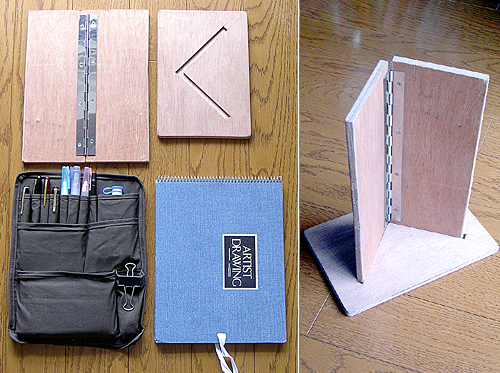 And here are my latest watercolor boxes. The one on the left is the Winsor Newton Deluxe Sketcher's Pocket Box. I took out the Cotman half pans and replaced them with 22 Holbein Shin Gansai pans which fit perfectly. The one on the right is a compact eyeshadow kit that cost around a dollar. I gave the eyeshadow to my 8 year old daughter and filled the wells with Holbein watercolors. It doesn't have a thumb ring but it's small enough to hold between the thumb and middle finger with the index finger supporting it underneath. That still gives me two fingers (at last count) to grip the top edge of the sketchbook. The bottom edge is resting on my stomach or chest. If I'm sitting on the stool then I rest the sketchbook on my lap which is at perfect drawing level. 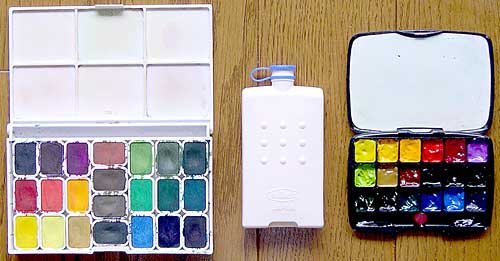 The slim white plastic bottle in the middle is for refilling the waterbrushes. I simply stick a waterbrush in the neck, invert the whole thing and start squeezing and releasing the waterbrush until it fills. Sure, a few drops of water dribble out during the process but I'm always outside when I do this. There's enough water for about ten refills with the smaller Kuretake type waterbrushes. The Pentel waterbrushes also fit the bottle neck but don't seem to fill as easily with the brush part attached. If you unscrew the brush part and try to fill the barrel, too much water dribbles out. The bottle is also made by Holbein. |
Next page >> |
 |